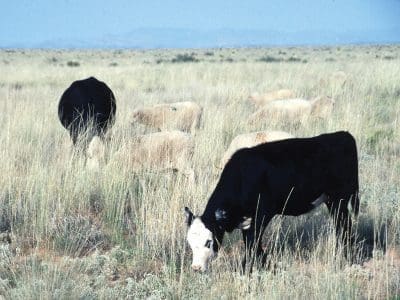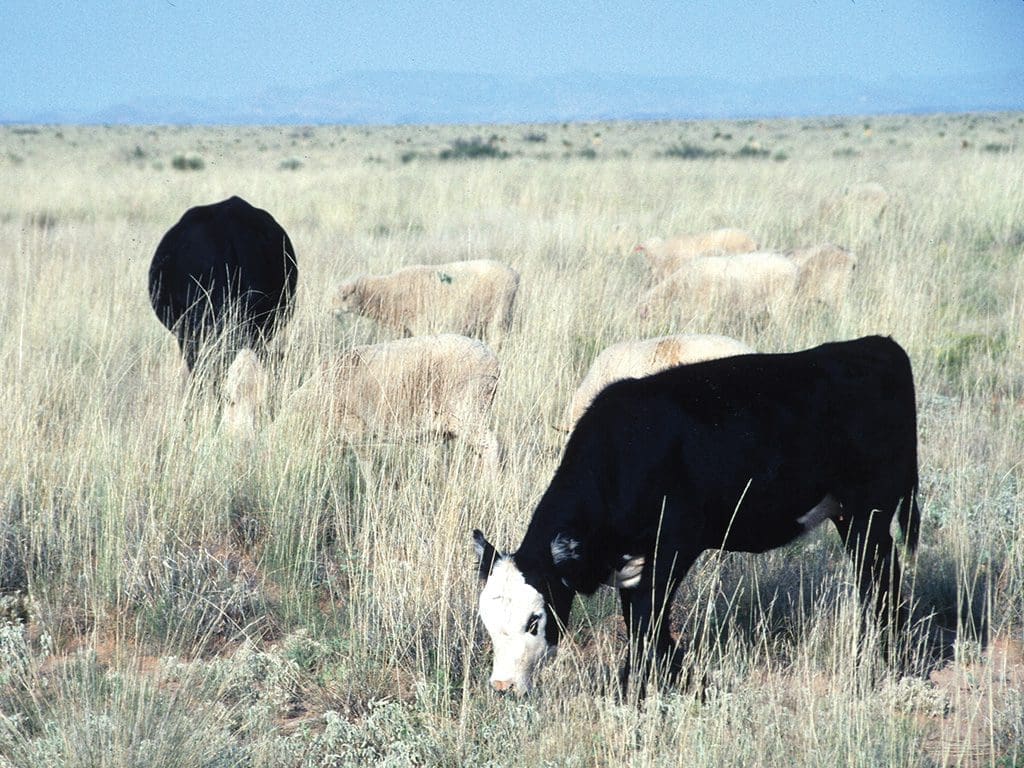By Patti Wilson, Contributing Editor
What are some feed contaminants that come to your mind, just off the top of your head? Mine include plastics, rodent waste, hardware or obvious mold. These are not only visible, but are most easily fixed because we can see them.
When researching this article, I discovered that this topic is huge. The issue of contaminants goes clear to the microscopic level and covers everything from grass to pet food. I also found the misinformed, emotional and even paranoid faction that is bent on using this subject to hinder animal agriculture.
 Start at the beginning
Start at the beginning
Though I’m primarily going to cover backgrounding and finishing procedures, let’s start at the start. Cows and grass. What could be cleaner than a pasture with cows, grass and sunshine? What about worms and worm eggs lurking in the leaves? Weed seeds are even considered a contaminant in the right circumstances. A dangerous but very unlikely scenario is chemical contaminants (think Chernobyl nuclear accident). More frequently, instances of endophyte fungus in fescue grass are to blame for harming grazing animals.
Much of the information in this article was gleaned from John Goeser, in three Hoard’s Dairyman articles dated Sept. 25, Oct. 10 and Oct. 25, 2017. Many thanks go to Goeser for his excellent materials.
Reality
Livestock feeds, particularly in the U.S., are more highly regulated than in other parts of the world. Therefore, our feeds are cleaner. Manufactured feedstuffs that are purchased from dealers and brought onto farms have government oversight through the Food Safety and Modernization Act. Farm-grown feeds such as hay, corn and silage pose little risk to the human food chain, with the exception of aflatoxin, which is already monitored at grain elevators.
Harvested feeds
Clean feeds start in the field, and your agronomist is part of the team. Make sure he or she sticks with you throughout the entire season.
Manure management is the first stop to make when considering field contaminants. Salmonella spp (all species) can survive for five years in a moist environment void of direct sunlight; Salmonella Dublin can survive one year in dry manure. Other bacteria can live in separated solids, manure, grey irrigation water and soil. Various potential pathogens include Clostridium spp, Listeria spp and E. coli spp. Never spread manure or contaminated water on a growing crop.
A relatively likely problem that occurs in stressed corn is mycotoxin, and its byproduct, aflatoxin. It can develop when conditions are extremely dry, too wet for long periods of time, damaged by storms or suffer inadequate storage after harvesting. Grain dealers are responsible for testing raw materials and answer to the Food and Drug Administration (FDA). These problems can be identified in the field before harvest.
What can contaminants do?
Effects of fungal and bacterial contaminants in feedstuffs are frequently fought off by healthy cattle. Robust rumens and immune systems are priceless in the real world where microbes, good and bad, live with us in our daily environment.
When cattle are stressed, however, immune suppression occurs, causing abortions or other reproductive failures, digestive problems and, occasionally, death. Be aware of a reduction in feed intake. It can be a sign of contamination.
Feed storage
The safest way to ensure minimum contamination and high quality feed is by using a bunker silo. Pack forages to greater than 50 pounds as-fed forage per cubic foot; forage pH should test at five or less. Avoid tracking dirt around the bunker. Ensile feedstuffs at the proper moisture and cover your piles.
Why cover? You must exclude air to prevent wild yeast and mold growth. These negative contaminants need oxygen to grow, producing toxic byproducts, decreasing digestibility and virtually ruining palatability. This means you also need to control holes in covers and bags.
Remember: good bacteria are lactic acid producers that grow in feedstuffs and acidify forage. It happens within days of harvest. Bad organisms need oxygen, break down protein, suppress feed intake and damage quality.
The cat’s meow
Rodents contribute greatly to feed contamination. Their feces can turn cattle away from the bunk and carry its own set of pathogens. Rats and mice destroy silage pile covers, admitting oxygen and causing spoilage. One sustainable method of rodent control is predation, by a healthy and stable set of cats. They’re effective, but require management, just like the rest of the livestock. Personally, I dislike them intensely, but have to concede that they work well when treated as working animals and not pets.
And now for an unwanted message that’s scarier than the word Vomitoxin – The Humane Society of the United States (HSUS) wants to remind us that, when employing rodent control, we need to treat the rats with the same respect and compassion as we treat our cattle. I include this message only to remind you that HSUS has infiltrated our every educational resource.
Finish it right
Feedout at the bunker is the final step requiring management to optimize quality. Feed cannot be removed from the bunker without exposing it to oxygen. Take steps to minimize the amount of silage openly exposed to air. Cut back enough plastic for a maximum of three days’ feeding. Check silage temperatures. The core and edges of your pile should never vary by more than 10 degrees. Look for rodent damage daily and repair holes immediately. These habits will minimize growth of wild yeasts.
When consulting Dr. Google for this article, I also found supposedly scientific papers concluding that our meat supply is frequently contaminated with antibiotics and secondary impurities ingested by livestock in their daily diets. This leads to only one giddy conclusion for animal rights activists – veganism is the only safe way to eat and rats need to be treated gently.
There are a lot of scared, misinformed people out there.
My final thought is, although we are the holders of the safest food supply in the world, we must never let our guard down in any faction of our business. We’re being watched.







